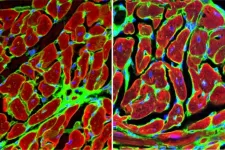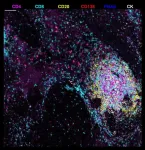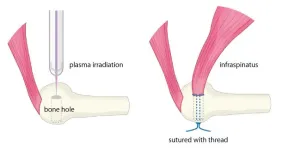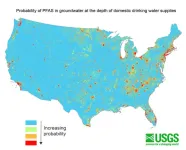(Press-News.org) FINDINGS
UCLA scientists have identified the protein GPNMB as a critical regulator in the heart’s healing process after a heart attack.
Using animal models, they demonstrate that bone marrow-derived immune cells called macrophages secrete GPNMB, which binds to the receptor GPR39, promoting heart repair. These findings offer a new understanding of how the heart heals itself and could lead to new treatments aimed at improving heart function and preventing the progression to heart failure.
BACKGROUND
Every 40 seconds, someone in the United States has a heart attack — the leading cause of heart failure. These cardiac events weaken the heart and cause scarring that reduces the heart’s ability to pump blood effectively. And while this scar tissue forms initially to maintain the heart’s structure, it remains permanently, straining the surviving muscle and eventually leading to heart failure.
Previous clinical studies have indicated that GPNMB, or glycoprotein non-metastatic melanoma protein B, has been strongly associated with cardiovascular outcomes of individuals with heart failure. What was not clear, however, was if lacking the protein was directly responsible for the development of heart failure after a heart attack. This important distinction — whether GPNMB is just an associated biomarker or one that plays a causal role — determines if the protein can be considered a therapeutic target for future studies.
METHOD
Utilizing mouse models, the researchers first established that GPNMB is not natively expressed by the heart itself but is produced by inflammatory cells originating from the bone marrow. After a heart attack, these macrophages travel to the site of injury in the heart, where they express GPNMB.
The team conducted gene knockouts — inactivating the GPNMB gene — [AS1] and bone marrow transplants and observed that mice lacking the GPNMB gene exhibited dramatically worse outcomes after a heart attack, including a higher incidence of heart rupture, a fatal complication also seen in human heart failure patients. Conversely, mice with normal GPNMB expression that were given an additional dose of circulating GPNMB protein showed improved heart function and reduced scarring. Four weeks after a simulated heart attack, 67% of the animals lacking the GPNMB gene exhibited severe fibrosis, or scarring, compared with only 8% of animals in the control group.
In addition to identifying GPNMB as a signaling molecule with effects across various cell types, the researchers uncovered that it binds to GPR39, previously considered an orphan receptor, or a receptor whose binding partner is not known. This interaction triggers a cascade of signals that promote tissue regeneration and limit scarring.
IMPACT
Cardiovascular disease — of which heart failure is a late-stage complication — is a significant health issue, accounting for approximately one-third of all deaths worldwide. Despite its prevalence, there are no available treatments that directly enhance the heart's ability to repair itself after a heart attack. The new study demonstrates the potential of GPNMB as a therapeutic agent, as well as GPR39 as a target, that can limit scarring, improve cardiac function and prevent heart failure.
This research could also have broader implications for understanding tissue repair in other organs. As GPNMB is expressed in multiple tissues, future studies will explore its role in the repair of the brain, kidneys and other organs impacted by ischemic injury.
AUTHORS
Dr. Arjun Deb, a professor of medicine and molecular, cell and developmental biology; director of the UCLA Cardiovascular Research Theme at the David Geffen School of Medicine at UCLA; and member of the Eli and Edythe Broad Center of Regenerative Medicine and Stem Cell Research, led the study. A full list of contributors is available in the journal.
JOURNAL
The study was published in Nature Cardiovascular Research.
FUNDING
This study was supported by grants from the National Institutes of Health.
DISCLOSURES
The therapeutic potential of GPNMB described in this study is under investigation and has not yet been tested in human clinical trials. The research findings are based on preclinical models, and further studies are required to assess safety and efficacy in humans.
END
UCLA researchers uncover novel role of protein GPNMB in heart repair
New study highlights a target for therapies to prevent heart failure after heart attacks
2024-10-25
ELSE PRESS RELEASES FROM THIS DATE:
Political polarization poses health risks, new analysis concludes
2024-10-25
News coverage of the 2024 election season has often centered on how partisan division has affected our politics. But a new analysis shows that political polarization also poses significant health risks—by obstructing the implementation of legislation and policies aimed at keeping Americans healthy, by discouraging individual action to address health needs, such as getting a flu shot, and by boosting the spread of misinformation that can reduce trust in health professionals.
“Compared to other high-income countries, the United States has a disadvantage when it comes to the health of its citizens,” ...
Lymph node-like structures may trigger the demise of cancer tumors
2024-10-25
**EMBARGOED FOR RELEASE UNTIL OCT. 25 AT 5 A.M. ET**
A newly described stage of a lymph node-like structure seen in liver tumors after presurgical immunotherapy may be vital to successfully treating patients with hepatocellular carcinoma, according to a study by researchers from the Johns Hopkins Kimmel Cancer Center.
The study, published Oct. 25 in Nature Immunology, provides new information about lymph node-like structures called tertiary lymphoid structures. These structures, which are highly organized ...
Pitchers rejoice? Plasma irradiation might prevent tendon re-tears
2024-10-25
The human body, filled with muscles and moving parts, is far from indestructible. Injuries are common, especially where tendons and bones connect. In Japan, rotator cuff tears affect approximately 1 in 4 people over age 50, and reports state that even after surgery, about 20% of cases result in re-tears. To combat this, new healing methods to bolster current clinical practices are needed.
Graduate student Katsumasa Nakazawa, Associate Professor Hiromitsu Toyoda, and then Professor Hiroaki Nakamura at Osaka Metropolitan University’s ...
The clinical significance of microvascular inflammation after kidney transplantation
2024-10-25
San Diego, CA (October 24, 2024) — Investigators recently uncovered key insights into newly defined rejection entities in kidney transplantation that may offer improved patient risk categorization post-transplant. The research will be presented at ASN Kidney Week 2024 October 23– 27.
Kidney transplant rejection continues to threaten the long-term success of kidney transplants, with microvascular inflammation (inflammation within capillaries) playing a pivotal role in graft failure. Due to its complex nature, this inflammation poses a major challenge in clinical practice. In response, the international Banff classification—the ...
The Lancet Public Health: New Commission calls for regulatory reform to tackle the health impacts of the rapid global expansion of commercial gambling
2024-10-24
**Embargo: 23.30 [UK time] / 06.30pm [US ET] Thursday 24th October 2024**
Peer reviewed / Literature review, systematic review and meta-analysis, opinion / People
Embargoed access to the Commission report and contact details for authors are available in Notes to Editors at the end of the release.
The Lancet Public Health: New Commission calls for regulatory reform to tackle the health impacts of the rapid global expansion of commercial gambling
Gambling harms are far more substantial than previously understood, exacerbated by rapid global expansion ...
Scientists create cancer patients’ ‘digital twins’ to predict how well treatments may work
2024-10-24
Barcelona, Spain: Researchers have shown that they can accurately re-create clinical trials of new treatments using ‘digital twins’ of real cancer patients. The technology, called FarrSight®-Twin, which is based on algorithms used by astrophysicists to discover black holes, will be presented today (Friday) at the 36th EORTC-NCI-AACR [1] Symposium on Molecular Targets and Cancer Therapeutics in Barcelona, Spain.
The researchers say that this approach could be used by cancer ...
New ‘mini-protein’ carries radiation dose directly to tumours without harming healthy tissues
2024-10-24
Barcelona, Spain: Researchers have shown for the first time that it is possible for a specially-designed ‘mini-protein’ to deliver a radiation dose directly to tumour cells expressing a protein on their cell surfaces called Nectin-4, which is often found in a number of different cancers.
In a study presented on Friday at the 36th EORTC-NCI-AACR [1] Symposium on Molecular Targets and Cancer Therapeutics in Barcelona, Spain, Mike Sathekge, Professor and Head of the Nuclear Medicine Department at the University of Pretoria ...
Patients with advanced bladder cancer with alterations in the FGFR3 gene respond well to investigational drug, TYRA-300
2024-10-24
Barcelona, Spain: Patients with advanced bladder cancer that had spread to other parts of the body (metastasised) have responded well in a phase I clinical trial of an investigational drug, TYRA-300. The drug targets changes in the FGFR3 gene that drive tumour growth in about 10%-20% of these patients.
Associate Professor, Ben Tran, a medical oncologist at Peter McCallum Cancer Centre in Melbourne, Australia, presented the first results as of 15 August 2024 from 41 patients enrolled in the SURF301 study in a late-breaking oral presentation at the 36th EORTC-NCI-AACR [1] Symposium on Molecular Targets and Cancer Therapeutics ...
Researchers find key genetic mutations in bowel cancer cells that lead to resistance to WRN inhibitors
2024-10-24
Barcelona, Spain: Researchers have discovered key mutations in certain cancer cells that make them resistant to WRN inhibitors, a new class of anti-cancer drugs. The yet-to-be-published findings are presented on Friday at the 36th EORTC-NCI-AACR [1] Symposium on Molecular Targets and Cancer Therapeutics in Barcelona, Spain.
Werner helicase (WRN) inhibitors are already being evaluated in phase I clinical trials in patients with tumours that have microsatellite instability (MSI) – a condition in which the genes responsible for monitoring and repairing mistakes in DNA replication stop functioning, and errors are introduced. This is also ...
Millions in the U.S. may rely on groundwater contaminated with PFAS for drinking water supplies
2024-10-24
PEMBROKE, N.H. — Approximately 71 to 95 million people in the Lower 48 states – more than 20% of the country’s population – may rely on groundwater that contains detectable concentrations of per- and polyfluoroalkyl substances, also known as PFAS, for their drinking water supplies. These findings are according to a U.S Geological Survey study published Oct. 24.
The predictive model results can help members of the public, water suppliers and regulators understand the potential for PFAS contamination, guide future studies and inform strategic planning for water resources.
USGS scientists are the first to ...
LAST 30 PRESS RELEASES:
Why nail-biting, procrastination and other self-sabotaging behaviors are rooted in survival instincts
Regional variations in mechanical properties of porcine leptomeninges
Artificial empathy in therapy and healthcare: advancements in interpersonal interaction technologies
Why some brains switch gears more efficiently than others
UVA’s Jundong Li wins ICDM’S 2025 Tao Li Award for data mining, machine learning
UVA’s low-power, high-performance computer power player Mircea Stan earns National Academy of Inventors fellowship
Not playing by the rules: USU researcher explores filamentous algae dynamics in rivers
Do our body clocks influence our risk of dementia?
Anthropologists offer new evidence of bipedalism in long-debated fossil discovery
Safer receipt paper from wood
Dosage-sensitive genes suggest no whole-genome duplications in ancestral angiosperm
First ancient human herpesvirus genomes document their deep history with humans
Why Some Bacteria Survive Antibiotics and How to Stop Them - New study reveals that bacteria can survive antibiotic treatment through two fundamentally different “shutdown modes”
UCLA study links scar healing to dangerous placenta condition
CHANGE-seq-BE finds off-target changes in the genome from base editors
The Journal of Nuclear Medicine Ahead-of-Print Tip Sheet: January 2, 2026
Delayed or absent first dose of measles, mumps, and rubella vaccination
Trends in US preterm birth rates by household income and race and ethnicity
Study identifies potential biomarker linked to progression and brain inflammation in multiple sclerosis
Many mothers in Norway do not show up for postnatal check-ups
Researchers want to find out why quick clay is so unstable
Superradiant spins show teamwork at the quantum scale
Cleveland Clinic Research links tumor bacteria to immunotherapy resistance in head and neck cancer
First Editorial of 2026: Resisting AI slop
Joint ground- and space-based observations reveal Saturn-mass rogue planet
Inheritable genetic variant offers protection against blood cancer risk and progression
Pigs settled Pacific islands alongside early human voyagers
A Coral reef’s daily pulse reshapes microbes in surrounding waters
EAST Tokamak experiments exceed plasma density limit, offering new approach to fusion ignition
Groundbreaking discovery reveals Africa’s oldest cremation pyre and complex ritual practices
[Press-News.org] UCLA researchers uncover novel role of protein GPNMB in heart repairNew study highlights a target for therapies to prevent heart failure after heart attacks





